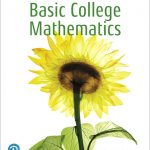Basic College Mathematics
$253.32
| Title | Range | Discount |
|---|---|---|
| Trade Discount | 5 + | 25% |
- Description
- Additional information
Description
For courses in Basic Mathematics.
Trusted author content. Thoughtful innovation.
Math hasn’t changed, but students – and the way they learn – have. In this revision of the Bittinger Worktext Series, the Bittinger author team brings their extensive experience to developmental math courses, paired with thoughtful integration of technology and content. The Bittinger Series enables students to get the most out of their course through their updated learning path, and new engaging exercises to support various types of student learning.
Bittinger offers respected content written by author-educators, tightly integrated with MyLabTM Math – the #1 choice in digital learning. Bringing the authors’ voices and their approach into the MyLab course gives students the motivation, engagement, and skill sets they need to master algebra.
Also available with MyLab Math
MyLabTM is the teaching and learning platform that empowers instructors to reach every student. By combining trusted author content with digital tools and a flexible platform, MyLab personalizes the learning experience and improves results for each student.
Note: You are purchasing a standalone product; MyLab Math does not come packaged with this content. Students, if interested in purchasing this title with MyLab Math, ask your instructor to confirm the correct package ISBN and Course ID. Instructors, contact your Pearson representative for more information.
If you would like to purchase both the physical text and MyLab Math, search for:
0134697456 / 9780134697451 Basic College Mathematics Plus NEW MyLab Math with Pearson eText – Access Card Package, 13/e
Package consists of:
- 0134689623 / 9780134689623 Basic College Mathematics
- 0135115604 / 9780135115602 MyLab Math with Pearson eText – Standalone Access Card – for Basic College Mathematics
Hallmark features of this title
- Margin Exercises help students apply concepts by solving problems that parallel the text Examples.
- Section Exercises include Skill Maintenance, Synthesis, and real-data Applications.
- Mid-Chapter Review with Concept Reinforcement, Guided Solutions, Mixed Review, and Understanding through Discussion and Writing helps students pause and actively review halfway through the chapter.
- Summary and Review at the end of each chapter includes:
- Vocabulary Reinforcement, Concept Reinforcement, Study Guide, Review Exercises, and Understanding through Writing and Discussion exercises.
- Chapter Tests, Chapter Test Prep videos, and Cumulative Review that review and reinforce skills and concepts.
About our authors
Marvin Bittinger has been teaching math at the university level for more than 38 years. Since 1968, he has been employed at Indiana University – Purdue University Indianapolis (IUPUI) and is now professor emeritus of mathematics education. Professor Bittinger has authored over 190 publications on topics ranging from basic mathematics to algebra and trigonometry to applied calculus. He received his BA in mathematics from Manchester College and his PhD in mathematics education from Purdue University. Special honors include Distinguished Visiting Professor at the United States Air Force Academy and his election to the Manchester College Board of Trustees from 1992 to 1999. His hobbies include hiking in Utah, baseball, golf, and bowling. Professor Bittinger has also had the privilege of speaking at many mathematics conventions, most recently giving a lecture entitled “Baseball and Mathematics.” He also has an interest in philosophy and theology, particularly apologetics. Professor Bittinger currently lives in Carmel, Indiana with his wife Elaine. He has 2 grown and married sons, Lowell and Chris, and 4 granddaughters.
Judy Beecher has an undergraduate degree in mathematics from Indiana University and a graduate degree in mathematics from Purdue University. She has taught at both the high school and college levels with many years of developmental math and precalculus teaching experience at Indiana University – Purdue University Indianapolis (IUPUI). In addition to her career in textbook publishing, she enjoys traveling, spending time with her grandchildren and promoting charity projects for a children’s camp.
Barbara Johnson has a BS in mathematics from Bob Jones University and a MS in mathematics from Clemson University, and is a PhD candidate in Educational Studies at Ball State University. She has taught high school and college math for 30 years, and she enjoys the challenge of helping each student grow in appreciation for and understanding of mathematics. As a Purdue Master Gardener, she also enjoys helping others learn gardening skills. Believing that the best teacher is always learning, she is also a student of karate.
New and updated features of this title
- New Chapter Opener applications with graphics use current data and applications to present the math in context. These applications are linked to exercises in the text to help students model, visualize and learn the math.
- New Student Activities begin with real-world data and guide students to examine a key concept in each chapter, while analyzing the data and connecting other concepts. There is 1 activity per chapter and they are available in the printed MyMathGuide.
- New Check Your Understanding with Reading Check and Concept Check exercises at the beginning of each section exercise set give students the opportunity to assess their grasp of the skills and concepts before they move on to the homework.
- New Skill Review in nearly every section of the text reviews a previously presented skill at the objective level where it is key to learning the new material.
- New Just-in-Time Review modules at the beginning of the text review the key topics from previous courses that are prerequisites for the new material in this course.
For courses in Basic Mathematics.
Trusted author content. Thoughtful innovation.
Math hasn’t changed, but students–and the way they learn–have. In this revision of the Bittinger Paperback Worktext Series, the Bittinger author team brings their extensive experience to developmental math courses, paired with thoughtful integration of technology and content. The Bittinger Series enables students to get the most out of their MyLab™ Math course through an updated learning path, new review videos, and new engaging exercises that offer the support they need, when they need it.
Bittinger offers market-leading content written by author-educators, tightly integrated with MyLab Math — the #1 choice in digital learning. Bringing the authors’ voices and their approach into the MyLab course encourages student motivation and engagement, while reinforcing their understanding of the skills and concepts they need to master algebra.
Also available with MyLab Math
MyLab™ Math is the teaching and learning platform that empowers you to reach every student. By combining trusted author content with digital tools and a flexible platform, MyLab personalizes the learning experience and improves results for each student. Learn more about MyLab Math.
- Index of Applications
- Preface
- Whole Numbers
- 1.1 Standard Notation
- 1.2 Addition
- 1.3 Subtraction
- 1.4 Multiplication
- 1.5 Division
- Mid-Chapter Review
- 1.6 Rounding and Estimating; Order
- 1.7 Solving Equations
- 1.8 Applications and Problem Solving
- Translating for Success
- 1.9 Exponential Notation and Order of Operations
- Summary and Review
- Test
- Fraction Notation: Multiplication and Division
- 2.1 Factorizations
- 2.2 Divisibility
- 2.3 Fractions and Fraction Notation
- 2.4 Multiplication and Applications
- 2.5 Simplifying
- Mid-Chapter Review
- 2.6 Multiplying, Simplifying, and Applications
- 2.7 Division and Applications
- Translating for Success
- Summary and Review
- Test
- Fraction Notation and Mixed Numerals
- 3.1 Least Common Multiples
- 3.2 Addition and Applications
- 3.3 Subtraction, Order, and Applications
- Translating for Success
- 3.4 Mixed Numerals
- Mid-Chapter Review
- 3.5 Addition and Subtraction Using Mixed Numerals; Applications
- 3.6 Multiplication and Division Using Mixed Numerals; Applications
- Translating for Success
- 3.7 Order of Operations, Complex Fractions, and Estimation
- Summary and Review
- Test
- Cumulative Review
- Decimal Notation
- 4.1 Decimal Notation, Order, and Rounding
- 4.2 Addition and Subtraction
- 4.3 Multiplication
- 4.4 Division
- Mid-Chapter Review
- 4.5 Converting from Fraction Notation to Decimal Notation
- 4.6 Estimating
- 4.7 Applications and Problem Solving
- Translating for Success
- Summary and Review
- Test
- Cumulative Review
- Ratio and Proportion
- 5.1 Introduction to Ratios
- 5.2 Rates and Unit Prices
- 5.3 Proportions
- Mid-Chapter Review
- 5.4 Applications of Proportions
- Translating for Success
- 5.5 Geometric Applications
- Summary and Review
- Test
- Cumulative Review
- Percent Notation
- 6.1 Percent Notation
- 6.2 Percent Notation and Fraction Notation
- 6.3 Solving Percent Problems Using Percent Equations
- 6.4 Solving Percent Problems Using Proportions
- Mid-Chapter Review
- 6.5 Applications of Percent
- Translating for Success
- 6.6 Sales Tax, Commission, and Discount
- 6.7 Simple Interest and Compound Interest; Credit Cards
- Summary and Review
- Test
- Cumulative Review
- Data, Graphs, and Statistics
- 7.1 Interpreting Data from Tables and Graphs
- 7.2 Interpreting and Drawing Bar Graphs and Line Graphs
- 7.3 Descriptive Statistics
- Mid-Chapter Review
- 7.4 Frequency Distributions and Histograms
- 7.5 Probability
- Translating for Success
- Summary and Review
- Test
- Cumulative Review
- Measurement
- 8.1 Linear Measures: American Units
- 8.2 Linear Measures: The Metric System
- 8.3 Converting Between American Units and Metric Units
- Mid-Chapter Review
- 8.4 Weight and Mass; Medical Applications
- 8.5 Capacity: Medical Applications
- 8.6 Time and Temperature
- 8.7 Converting Units of Area
- Translating for Success
- Summary and Review
- Test
- Cumulative Review
- Geometry
- 9.1 Perimeter
- 9.2 Area
- 9.3 Circles
- Mid-Chapter Review
- 9.4 Volume
- 9.5 Angles and Triangles
- 9.6 Square Roots and the Pythagorean Theorem
- Translating for Success
- Summary and Review
- Test
- Cumulative Review
- Real Numbers
- 10.1 The Real Numbers
- 10.2 Addition of Real Numbers
- 10.3 Subtraction of Real Numbers
- Mid-Chapter Review
- 10.4 Multiplication of Real Numbers
- 10.5 Division of Real Numbers and Order of Operations
- Translating for Success
- Summary and Review
- Test
- Cumulative Review
- Algebra: Solving Equations and Problems
- 11.1 Introduction to Algebra
- 11.2 Solving Equations: The Addition Principle
- 11.3 Solving Equations: The Multiplication Principle
- Mid-Chapter Review
- 11.4 Using the Principles Together
- 11.5 Clearing Fractions and Decimals
- 11.6 Applications and Problem Solving
- Translating for Success
- Summary and Review
- Test
- Cumulative Review
- Answers
- Glossary
- Photo Credits
- Index
Additional information
| Dimensions | 1.20 × 8.60 × 10.85 in |
|---|---|
| Imprint | |
| Format | |
| ISBN-13 | |
| ISBN-10 | |
| Author | |
| Subjects | mathematics, higher education, basic math, Developmental Math |



